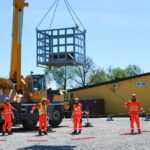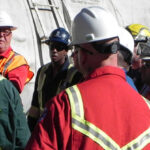
A confined space program is essential for ensuring the safety of workers who must enter and work in confined spaces. These spaces can pose significant risks, including toxic atmospheres, engulfment, entrapment, and other hazards. A comprehensive confined space program typically includes the following elements:
1. Identification and Classification of Confined Spaces
– Inventory: Identify all confined spaces in the workplace.
– Classification: Classify each confined space as either a “permit-required confined space” (PRCS) or a “non-permit confined space” based on the hazards present.
2. Hazard Assessment
– Risk Evaluation: Conduct a thorough assessment of potential hazards, including atmospheric, physical, and biological risks.
– Monitoring: Use appropriate equipment to test for hazardous conditions such as oxygen levels, flammable gases, and toxic substances.
3. Permit System
– Permit-Required Confined Spaces: Develop a permit system for entry into PRCS, including detailed procedures and documentation.
– Permit Contents: Ensure permits include information such as the purpose of entry, authorized entrants, attendants, entry supervisors, hazards present, and protective measures.
4. Training and Competency
– Employee Training: Provide comprehensive training for all employees involved in confined space entry, including entrants, attendants, and supervisors.
– Competency Assessment: Ensure that workers demonstrate competency in entry procedures, hazard recognition, and emergency response.
5. Entry Procedures
– Pre-Entry Preparation: Establish procedures for preparing the space for entry, including isolation, ventilation, and purging.
– Entry Protocol: Define the steps for safe entry, work, and exit from the confined space.
6. Atmospheric Testing and Monitoring
– Continuous Monitoring: Implement continuous atmospheric monitoring during entry to detect any changes in conditions.
– Calibration and Maintenance: Regularly calibrate and maintain monitoring equipment to ensure accuracy.
7. Personal Protective Equipment (PPE)
– Selection and Use: Provide appropriate PPE, such as respirators, harnesses, and protective clothing, and ensure workers are trained in their use.
– Inspection and Maintenance: Regularly inspect and maintain PPE to ensure it is in good working condition.
8. Rescue and Emergency Procedures
– Rescue Plan: Develop and implement a rescue plan specific to each confined space, including procedures for both non-entry and entry rescues.
– Emergency Equipment: Ensure that rescue equipment, such as retrieval systems and first aid supplies, is readily available and in good condition.
– Training and Drills: Conduct regular training and drills to ensure that rescue teams are prepared to respond effectively in an emergency.
9. Communication and Coordination
– Communication Systems: Establish reliable communication systems between entrants, attendants, and supervisors.
– Coordination with External Services: Coordinate with external emergency services if necessary and ensure they are aware of the hazards and rescue procedures.
10. Documentation and Recordkeeping
– Permits and Logs: Maintain detailed records of all confined space entries, including permits, hazard assessments, and monitoring results.
– Incident Reports: Document any incidents or near-misses and conduct thorough investigations to prevent recurrence.
11. Program Review and Auditing
– Regular Reviews: Periodically review and update the program to reflect changes in workplace conditions, regulations, and best practices.
– Audits and Inspections: Conduct regular audits and inspections to ensure compliance with the program and identify areas for improvement.
12. Regulatory Compliance
– Adherence to Standards: Ensure the program complies with relevant regulations and standards, such as OSHA 29 CFR 1910.146 in the United States or equivalent regulations in other jurisdictions.
– Updates and Changes: Stay informed about changes in regulations and update the program accordingly.
By incorporating these elements, a confined space program can effectively mitigate the risks associated with confined space entry and ensure the safety and health of workers.
Primelift Safety Resources Limited offers training in confined space entry and rescue.
Call us on +234 9115687051. Email us on training@primeliftsafetyng.com
www.primeliftsafetyng.com










